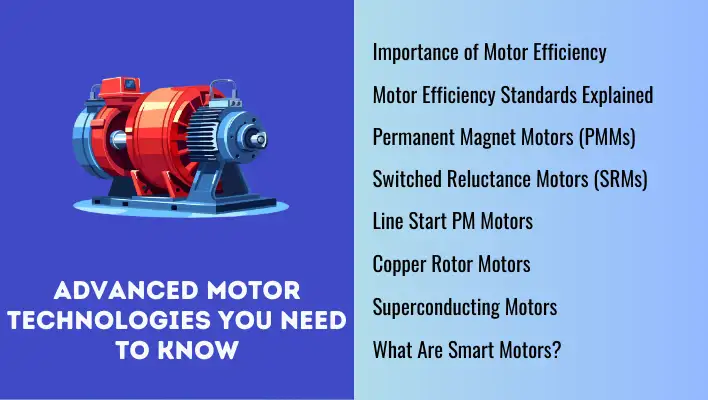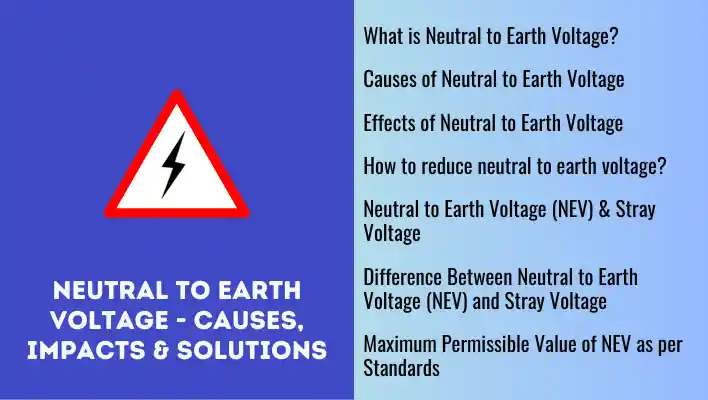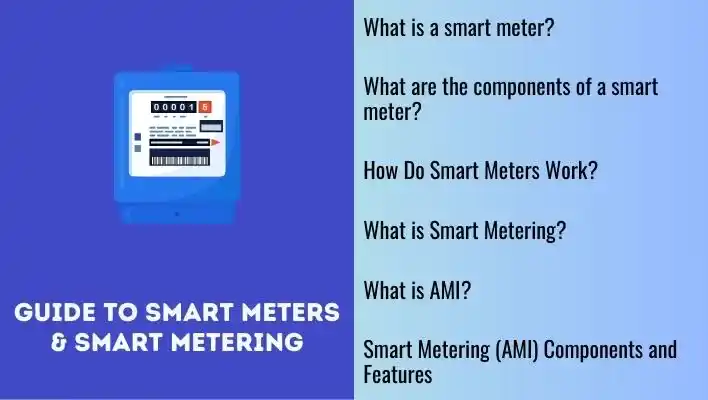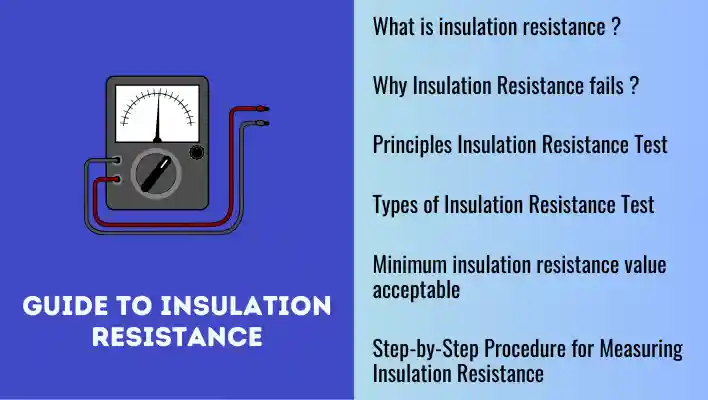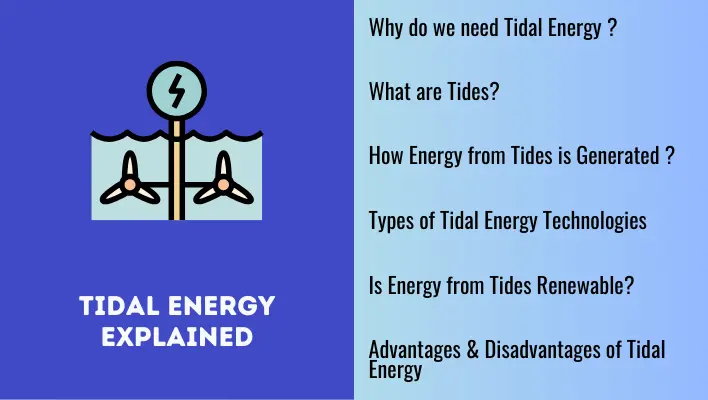In industrial electrical systems, star delta starter play an important role in efficiently starting and controlling three-phase induction motors. This post explores their basic principles, operations and significance. Understanding star delta starters is essential for optimizing machinery performance. So let us discover How They Work & Why They Matter.
Also Read: Decoding DOL Motor Starter | A Complete Guide
What is Star Delta Starter?
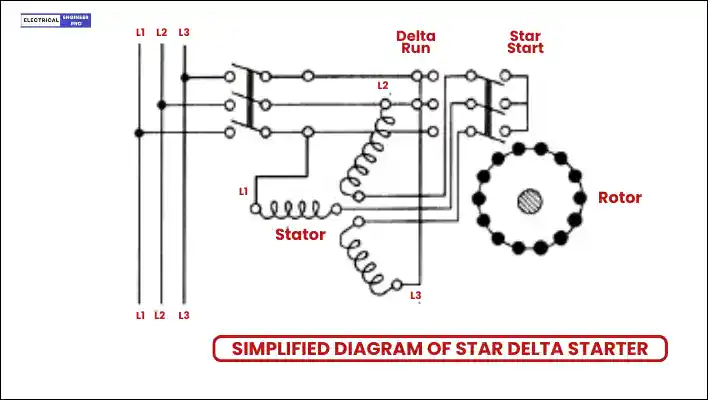
A star delta starter is a type of motor starter used in three-phase induction motors to reduce the starting current and torque during motor start-up. This is particularly useful for large motors where the initial current surge could be too high and cause damage to the motor or the power supply system.
But why is it called Star Delta Starter?
The definition provided by IEC 60947-4-1:2023 sheds some clarity on this matter. It says,
“Star-delta starters intended to start a three-phase motor in the star connection, to ensure
continuous operation in the delta connection, to provide means for the protection of the motor and its associated circuits against operating overloads, and to switch off the supply from the motor.”
Let’s analyze the definition and explore the reasons why it’s referred to as a star delta starter.
The star-delta starter gets its name because it deals with two specific arrangements involved in its operation: the star connection and the delta connection.
- Star Connection: In the initial phase of starting a motor, the windings are connected in a star configuration. This arrangement reduces the starting current drawn by the motor, which helps prevent excessive strain on the electrical system. It also allows for smoother acceleration of the motor.
- Delta Connection: After the motor has reached a certain speed, the starter switches the motor windings from the star configuration to the delta configuration. In the delta configuration, the motor operates at its full efficiency and power. This transition ensures continuous operation of the motor under optimal conditions once it has started.
Additionally, the star-delta starter serves several other essential functions:
- Protection against Overloads: It includes mechanisms to safeguard the motor and its associated circuits from operating overloads. This protection is crucial for preventing damage to the motor and ensuring long life.
- Switching off Supply: The starter also provides a means to disconnect the power supply from the motor when necessary. This feature allows for controlled stopping of the motor and ensures safety during maintenance or emergency situations.
In summary, the name “star-delta starter” conveys its primary function of sequentially connecting the motor windings in star and delta configurations during the start-up process, along with its role in protecting the motor and controlling the power supply.
Also Read: In-Depth Guide to Variable Frequency Drives (VFD)
Components of Star Delta Starter
The components of a star delta starter include:
- Three Contactors: These are smaller than the single contactor used in a Direct On Line starter. Two of these contactors are closed during the run phase:
- Main Contactor: This contactor, along with the delta contactor, controls winding currents during operation.
- Delta Contactor: Works in conjunction with the main contactor to manage winding currents during operation.
- Star Contactor: This contactor is responsible for carrying the star current while the motor is connected in star configuration.
- Timer: The starter includes a timer to control the switching between star and delta configurations. This timer ensures that the transition between the two states occurs smoothly and at the appropriate time.
- Thermal Overload: This component is crucial for protecting the motor from overheating. It monitors the motor’s temperature and interrupts the circuit if the temperature exceeds a safe threshold, preventing damage to the motor due to excessive heat.
- Control circuit: The control circuit includes various switches, push buttons, and other control devices used to start, stop, and control the operation of the motor.
Also Read: AC Motor | Construction, Types, Advantages & Applications
Working Principle of Star Delta Starter
The working principle of Star delta Starter requires a motor to be built with Delta connected stator winding.
The Star Delta starter is based on the concept that in Star configurations, the voltage across each winding equals the phase voltage, which is 1/√3 times the line voltage, while in Delta configurations, each winding receives the full line voltage.
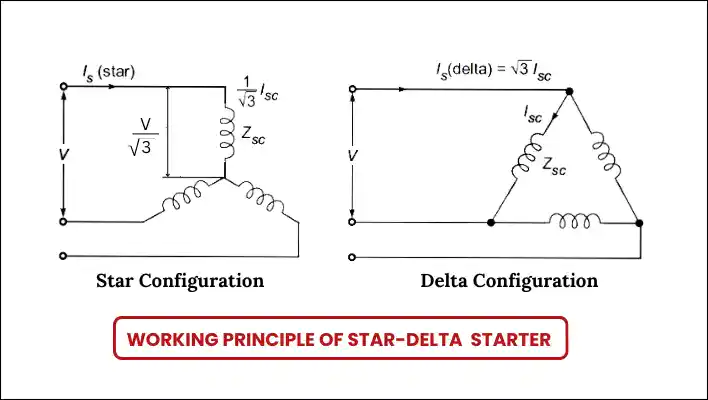
Let’s understand how it works with a simple explanation.
Since the stator windings are initially connected in a star configuration during startup, the voltage across each phase winding is reduced to 1/√3 of the line voltage. As a result, the starting current / phase becomes equal to,
Starting line current (Isc) in Star configuration (Is) = Isc/√3
The starting line current when directly switching with the stator winding connected in delta configuration is equal to,
Starting line current (Isc) in Delta configuration (Is) = √3 Isc
Therefore, the ratio of line currents drawn in star and delta connection is,

Hence, it is concluded that the starting current when the stator winding is connected in Star configuration is 1/3rd of the value compared to when it is connected in Delta configuration.
Further, the torque developed by an induction motor is proportional to the square of the applied voltage. As the phase voltage is reduced to 1/ √3 times that in star-connection, the starting torque will also be reduced to one-third.
Also Read: Explore the Diverse World of DC Motors
Power Circuit Diagram of Star Delta Starter
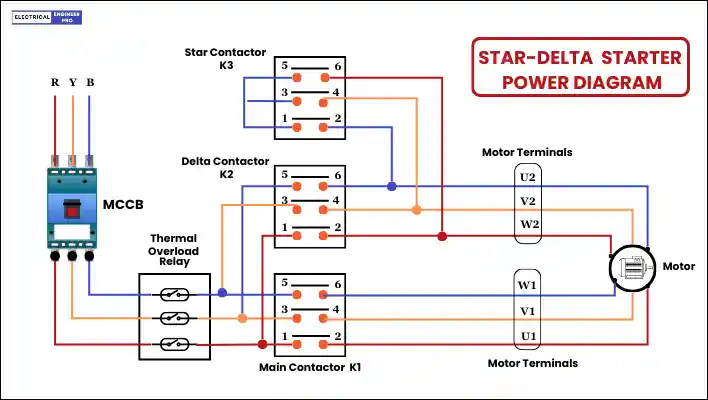
The power circuit of a star-delta starter manages the electrical flow to the motor and mobilizes its starting process. Here are the details,
- Main Circuit Breaker: This switch acts as the primary controller of electrical power flow, allowing or interrupting the supply of electricity to the power circuit. It ensures safety by providing a means to quickly disconnect power in case of emergencies or maintenance needs.
- Main Contactor: Positioned after the main circuit breaker, the main contactor is responsible for connecting the reference source voltage phases (R, Y, B) to the primary terminals of the motor (U1, V1, W1). It is the essential link between the power supply and the motor, facilitating the flow of electricity to the motor.
- Operation Sequence: When the starter receives power supply after closing of MCB, both the Main Contactor (K1) and the Star Contactor (K3) are closed. This configuration enables power to flow through the star configuration, reducing the starting current. After a predefined period, the star contactor is opened, and subsequently, the delta contactor (K2) is closed. This transition from star to delta configuration is typically controlled by a timer integrated into the starter.
- Interlocking: For safety and proper operation, Star and Delta contactors are electrically interlocked, ensuring that only one contactor can be closed at any given time. Mechanical interlocking further enhances this safety measure, preventing incorrect configurations that could damage the motor or starter.
- Star Contactor: During the initial run of the motor from standstill, the star contactor serves to short the secondary terminals of the motor (U2, V2, W2). This action creates a star connection, providing one-third of line current to the motor. This reduces the high inrush current typically associated with starting large capacity motors, minimizing stress on the electrical system.
- Delta Contactor: Upon completion of the star configuration, the delta contactor is engaged, transitioning the motor to a delta connection. This connection enables the motor to operate efficiently under normal running conditions.
Also Read: Electrical Transformers | A Deep Dive into its Mechanics
Control Circuit Diagram of Star Delta Starter
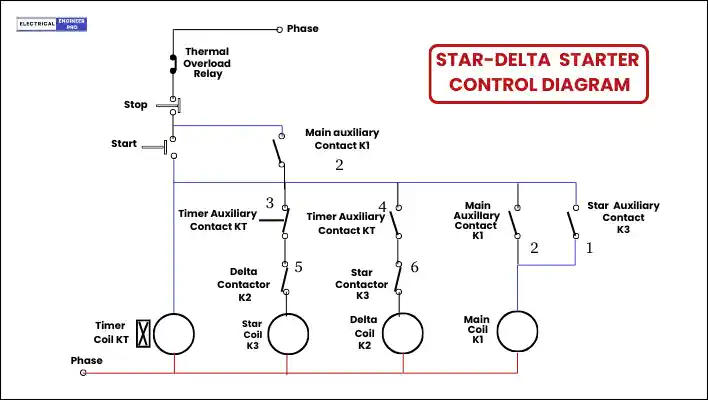
The control circuit of a star-delta starter is pivotal in managing the initiation and sequence of operations for starting and controlling the motor. Here’s a detailed explanation,
- Starting Sequence: The control circuit is initiated by pressing the ON push button, which first energizes the Star Contactor Coil (K3) and the Timer Coil (KT) circuit.
- Star Contactor Activation: When the Star Contactor Coil (K3) is energized, the Star Main and Auxiliary contactors switch positions from Normally Open (NO) to Normally Closed (NC).
- Main Contactor Engagement: As the Star Auxiliary Contactor (1) shifts from NO to NC, it completes the circuit of the Main Contactor Coil (K1), energizing it. Consequently, the Main Contactor’s Main and Auxiliary contacts also transition from NO to NC, all occurring in a fraction of time.
- Latch Mechanism: Once the ON push button is released, the auxiliary contact (2) of the Main Contactor Coil, connected in parallel across the push button, changes from NO to NC, creating a latch. This ensures that the Main Contactor Coil remains energized, maintaining the control circuit’s activity even after the push button is released.
- Star Connection: With the Star Main Contactor (K3) closed, the motor is connected in the star configuration. This connection remains until the Time Delay Auxiliary contact KT transitions from NC to Normally Open (NO).
- Transition to Delta Connection: Once the specified time delay elapses, the timer’s auxiliary contacts (KT) in the Star Coil circuit shift from NC to NO. Simultaneously, the Auxiliary contactor (KT) in the Delta Coil Circuit (4) switches from NO to NC, energizing the Delta coil. Consequently, the Delta Main Contactor switches from NO to NC, altering the motor terminal connection from star to delta configuration.
- Interlocking Safety Mechanism: Auxiliary contacts (5 & 6) from both star and delta contactors are placed opposite their respective coils. These interlock contacts act as safety switches, preventing simultaneous activation of both star and delta contactor coils. This ensures that one cannot be activated without the other being deactivated first, enhancing safety during operation.
- Shutdown Mechanism: The control circuit includes two interrupting contacts for shutting down the motor. The OFF push button switch breaks the control circuit when required. Additionally, the thermal overload contact, part of the thermal overload relay, automatically opens the STOP control circuit if motor overload current is detected. This prevents motor burnout in case of excessive load beyond the motor’s rated capacity, detected by the thermal overload relay.
This operation is termed “open transition switching” because it involves an open state positioned between the star state and the delta state.
Also Read: Synchronous Electric Generator | Principles & Working
Types of Star Delta Starters
Open Transition
An open transition refers to the momentary interruption or disconnection of the power supply when a motor is transitioned between different configurations or states, such as from star to delta configuration
During an open transition, like in a star-delta starter, when the motor switches from the star configuration to the delta configuration, there’s a brief period where the motor is disconnected from the power source.
In this period, the rotor continues to spin within the stator, maintaining its magnetic field. As the rotor circuit’s impedance is low, the time constant is extended, the spinning rotor field behaves like a generator within the stator, generating voltage at a frequency determined by the rotor speed.
Upon reconnection to the power supply in Delta state, the motor essentially closes onto this unsynchronized generator. This abrupt reconnection can lead to a sharp surge in current and torque, potentially causing electrical and mechanical damage.
Open transition starting is the simplest and most cost-effective method to implement. It is most effective when the timing of the changeover is properly set.
However, in practical applications, it can be challenging to establish the necessary timing for correct operation, and the disconnection and reconnection of the power supply can result in significant voltage and current transients.
There are four distinct states open transition starting, (Refer above Power Circuit Diagram)
- OFF State: All contactors are open.
- Star State: The main contactor (K1) and the star contactor (K3) are closed, while the delta contactor (K2) remains open. The motor is connected in a star configuration, producing one-third current and torque of the power supply it receives.
- Open State: This phase is termed open transition switching because there’s an open state between the star state and the delta state. In this state, only the main contactor is closed, while both the delta and star contactors are open. Although there’s voltage on one end of the motor windings, the other end is open, preventing current flow. The motor’s rotor spins, behaving like a generator during this phase.
- Delta State: Both the main and delta contactors are closed, while the star contactor remains open. The motor is connected to full line voltage, providing full power and torque capability.
Closed Transition

In a close transition, the motor remains connected to the power supply throughout the transition process.
To mitigate the impact of switching transients, close transition starters employ a fourth contactor alongside a set of three resistors. These resistors are rated to facilitate significant current flow within the motor windings while they are active in the circuit.
The auxiliary contactor and resistors are linked across the delta contactor. During operation, just prior to the opening of the star contactor, the auxiliary contactor engages, enabling current to pass through the resistors into the star connection.
Upon the star contactor’s opening, current can then circulate through the motor windings to the power supply via the resistors.
Subsequently, the delta contactor shorts these resistors. However, if the resistance of the resistors exceeds a certain threshold, they fail to sufficiently counteract the voltage generated by the motor and become ineffective.
Close transition involves five distinct states:
- OFF State: All contactors are open.
- Star State: The Main contactor (K1) and the Star contactor (K3) are closed, while the delta contactor (K2) remains open. The motor operates in star configuration, delivering one-third of the Direct-On-Line (DOL) torque at one-third of the DOL current.
- Star Transition State: The motor remains connected in star configuration, while resistors are linked across the delta contactor via the auxiliary contactor (K4).
- Closed Transition State: The Main contactor (K1) is closed, and both the Delta (K2) and Star (K3) contactors are open. Current flows through the motor windings and the transition resistors via K4.
- Delta State: Both the Main and Delta contactors are closed. The transition resistors are shorted out. The Star contactor remains open. The motor is now linked to full line voltage, providing full power and torque capability.
Also Read: What is Current Transformer? How it Works?
Advantages of Star Delta starters
Star-delta starters offer several advantages in controlling the starting process of induction motors:
- Reduced Starting Current: Star-delta starters significantly reduce the starting current drawn by the motor during the startup phase. This reduced voltage decreases the stress on the electrical system and prevents voltage drops in the power supply system.
- Minimized Voltage Drop: Starting the motor in star arrangement reduces the risk of voltage drop in the power system.
- Lower Mechanical Stress: Due to reduced starting current, the motor runs smoother during startup.This helps in minimizing mechanical stress on the motor and associated equipment. Thus extending the lifespan of motor and equipment connected to it.
- Cost Savings: Star-delta starters are generally more cost-effective compared to other starting methods, especially in applications where frequent starts are not required. The reduced starting current can also lead to energy savings over time, contributing to lower operating costs.
- Improved Power Factor: When operating in the star configuration, the motor exhibits a higher power factor compared to direct-on-line starting methods. This improved power factor can result in better overall system efficiency and reduced energy consumption.
- Simplified Control: Star-delta starters offer a simple and reliable method of controlling the starting process of induction motors. They typically involve straightforward switching between star and delta configurations, making them easy to operate and maintain.
- Suitability for High-Power Motors: Star-delta starters are particularly suitable for high-power motors where the starting current can be several times higher than the rated current. By effectively reducing this initial surge of current, they help to protect both the motor and the electrical system from damage.
Also Read: Potential Transformers – Principles, Types & Uses
Disadvantages of Star Delta Starters
While star-delta starters offer several advantages, they also have some limitations and drawbacks:
- Limited to Low-to-Medium Starting Torque Applications: Star-delta starters are not suitable for applications requiring high starting torque during the initial startup phase. This limitation can restrict their use in certain industrial processes where high starting torque is necessary, such as heavy-duty conveyor systems or crushers.
- Inability to Start Under Load: Star-delta starters cannot start the motor under load. The motor must be at rest before switching between the star and delta configurations. This limitation can be inconvenient in applications where frequent starts under load are required.
- Complexity of Control Circuit: The control circuitry for star-delta starters can be more complex compared to other starting methods, such as direct-on-line starters. This complexity can increase installation and maintenance costs, as well as the risk of electrical faults if not properly designed and maintained.
- Potential Voltage Imbalance: During the transition from the star to the delta configuration, there can be a brief period of voltage imbalance across the motor windings. This imbalance can lead to uneven torque distribution and increased mechanical stress on the motor, particularly in older or poorly maintained systems.
- Higher Installation Cost: While star-delta starters are generally more cost-effective than other starting methods in the long run, they may have a higher initial installation cost due to the complexity of the control circuitry and the need for specialized components.
- Not Suitable for Reversing Operation: Star-delta starters are typically designed for one-directional motor operation and may not be suitable for applications requiring frequent reversing of the motor’s direction.
- Space Requirements: Star-delta starters may require more space compared to other starting methods, especially in applications where multiple starters need to be installed in a limited space.
Direct On Line (DOL) Vs Star Delta starters
| Direct On Line (DOL) | Star Delta starters |
| Motor is directly connected to the power supply at full voltage. | Motor is initially connected in star configuration, then switched to delta configuration. |
| High starting current, typically 5 to 7 times the full load current. | Reduced starting current, approximately one-third of the DOL starter. |
| Full starting torque immediately upon starting. | Reduced starting torque during the star configuration, then full torque after switching to delta configuration. |
| Full supply voltage applied to the motor from the start. | Reduced voltage during star connection, then full voltage during delta connection. |
| No transition period, immediate application of full voltage. | Transition time between star and delta connection typically set by a timer or based on motor speed. |
| Relatively low cost. | Higher cost. |
| Suitable for smaller motors with low starting torque requirements. | Preferred for larger motors with high starting torque requirements or limited power supply capacity. |
| High starting current may cause voltage dips in the power supply. | Reduced starting current mitigates voltage dips and mechanical stress on the motor and power supply. |
| Higher mechanical stress on the motor due to immediate application of full torque. | Reduced mechanical stress on the motor due to gradual torque application. |
| May require additional overload protection devices due to high starting current. | Reduced starting current mitigates the need for additional overload protection. |
| Lower energy efficiency during start-up due to high starting current. | Potentially higher energy efficiency due to reduced starting current. |
| Simple control with only one contactor required. | Requires more complex control with two contactors and a timer or control logic. |
Star Delta Starter FAQs
Why is star-delta starter used instead of DOL starter?
A Star-Delta starter is used instead of a DOL starter primarily to reduce the starting current drawn by the motor and to minimize mechanical stress during startup.
Can we use VFD in star-delta starter?
Yes, Variable Frequency Drives (VFDs) can be used in conjunction with a Star-Delta starter in certain applications. The combination of a VFD with a Star-Delta starter provides more control and flexibility over the motor’s operation, especially in scenarios where precise speed control and energy efficiency are required.
Which types of motors are used with Star Delta Starters?
Star Delta starters are typically suitable for three-phase induction motors with a delta-wound stator. Motors with star-wound stators may not be compatible with this configuration.
Can a Star-Delta starter be controlled manually or automatically?
Star-Delta starters can be operated manually using push buttons or switches, or they can be automated using timers, PLCs, or other control systems for automatic operation.
What are the typical applications of Star-Delta starters?
Star-Delta starters are commonly used in various industrial applications, including conveyor systems, pumps, compressors, fans, and other equipment where reducing starting current and mechanical shock are critical.


